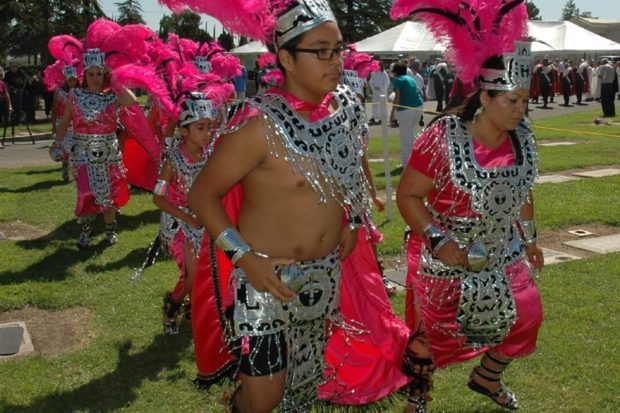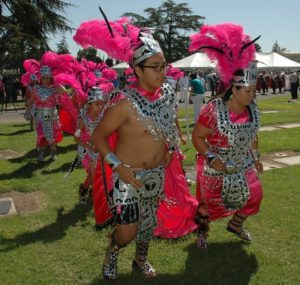
By Dixie Salazar

(Editor’s note: The following interview by Dixie Salazar [DS] with Lance Canales [LC] gives our readers background and insight into a ceremony and celebration that took place in Fresno on Labor Day weekend to commemorate farmworkers killed in a 1948 plane crash.)
DS: What is the background on the plane crash and the song about it, and why did these people going nameless for so long capture people’s attention?
LC: One morning in 1948, a plane chartered by U.S. Immigration Services, carrying 32 people, including 28 farmworkers, left Oakland bound for the Mexican border. It went down in a fireball over Los Gatos Canyon, near the oil fields of Coalinga. Many of the laborers were part of the bracero work program and had finished their government-sponsored contracts. Others had entered the country illegally.
Everyone on the plane died. It was one of the worst aviation disasters of the era and was widely reported. But the farmworkers were buried without names in a mass grave in Fresno. Struck by their anonymity, Woody Guthrie wrote the poem “Plane Wreck at Los Gatos—Deportee.”
Later, a schoolteacher, Martin Hoffman, set the words to music. It was recorded publicly first by Pete Seeger and then by a string of artists including Bruce Springsteen, Dolly Parton and Johnny Cash. The song was passed down and memorized, a protest to both the grave marker with no names and to the idea that some lives don’t matter as much as others. But the real names of the people in that grave were forgotten.
 DS: What happened at the event on Labor Day at the Holy Cross Cemetery on Belmont Avenue in Fresno?
DS: What happened at the event on Labor Day at the Holy Cross Cemetery on Belmont Avenue in Fresno?
LC: On Sept. 2, a 65-year-old question was answered. “Who are these friends all scattered like dried leaves?” These “friends” were Guthrie’s deportees and had been buried nameless, with only a sign that read “28 Mexican citizens who died in an airplane accident near Coalinga, California, on Jan. 28, 1948. R.I.P.” Now, some 65 years later on Sept. 2, 2013, their names have been restored. On an 8-foot by 4-foot granite headstone all 28 farmworker names and the names of the four crew members are forever engraved.
People came from all over the country to share in this historic event. As Diana Marcum described in a Sept. 2 Los Angeles Times article, “Nuns in habits, priests in white robes, Aztec dancers in pink feather headdresses, middle-aged folk-song fans, aged braceros, children shading themselves with umbrellas and many multigenerational families whose grandfathers could have been on that plane” chanted “Descanse en paz” (Rest in peace).
DS: Why is it significant, even of national interest?
 LC: Immigration is and always has been big news. But what makes this story stand out (although their names had been omitted from the original news broadcast) is that these people have been written back into history by Guthrie, an American icon.
LC: Immigration is and always has been big news. But what makes this story stand out (although their names had been omitted from the original news broadcast) is that these people have been written back into history by Guthrie, an American icon.
This is a sad story that has many parts to it that involve famous folksingers, rock stars and a Central Valley community that knows all about the thankless struggles and hardships of the migrant farmworker. Although the entire nation’s politicians are battling each other on immigration reform, for and against, not making any progress for change, the real stories of hard labor, death and hardship are falling through the cracks unnoticed.
It’s a story that would have been forgotten if it weren’t for Guthrie’s poem, “Plane Wreck at Los Gatos—Deportee” and Hoffman’s putting it to music and keeping it alive for over 65 years. There are so many other cases that have been forgotten or lost, but this made headlines because of its connection to the arts and the artists themselves singing it forward in time.
 DS: Why did this event happen now? Who organized it and why? Who are some of the people you met through this experience and how did they touch your life?
DS: Why did this event happen now? Who organized it and why? Who are some of the people you met through this experience and how did they touch your life?
LC: This project didn’t start out with a political agenda. It began as an artistic expression between a poet and a musician at a 100-year celebration for Woody Guthrie in Salinas on May 4, 2012, when Tim Z. Hernandez was asked to take part in the National Steinbeck festival. The climax of Tim’s and my performance was my version of “Deportee,” with Tim reading the names of the lost 28 farmworkers omitted from history.
Nora Guthrie, daughter of Woody Guthrie, and president of the Guthrie Foundation, approached us with tears in her eyes following the performance. She told us how important names were to her father and how this was the very thing that made him write the poem. It was just so moving to hear the way she spoke of her father and, honestly, it was the spark that ignited the idea that was to come only hours later. When the lights went down after the show, we knew we had to do something more.
That day in Salinas, these powerful feelings of empathy for the families of the unnamed victims brought about a conversation between myself and Tim. We could not let them continue to remain nameless, so we took the idea for a memorial to the Holy Cross Cemetery director, Carlos Rascon, who found that we needed to raise $10,000 for a memorial.
 We recorded our song with the 28 names and released it with the idea that all the proceeds would go to the headstone. We debuted the story and the song first on KFCF’s Waste Land of the Free with Rick Flores, to begin raising money by getting the word out to the Central Valley community who we knew would be the key to raising the $10,000. We then told the story on radio stations such as NPR, KPFA, Valley Public Radio and Radio Bilingue. A local TV station, Univision, aired a three-day, three-part documentary short of the story.
We recorded our song with the 28 names and released it with the idea that all the proceeds would go to the headstone. We debuted the story and the song first on KFCF’s Waste Land of the Free with Rick Flores, to begin raising money by getting the word out to the Central Valley community who we knew would be the key to raising the $10,000. We then told the story on radio stations such as NPR, KPFA, Valley Public Radio and Radio Bilingue. A local TV station, Univision, aired a three-day, three-part documentary short of the story.
Next came a benefit concert and art show that raised a huge chunk of the money needed to meet the goal. Local artists such as John Sierra (who also did the papel picado for the memorial) teamed up with Bay Area artists and donated fine art pieces for a silent art action that helped bring in a big portion of the money. A Dinuba school teacher, Mrs. Guzman, and her students had a bake sale to help raise money.
The story was told by people all across the country like ripples in a pond, starting in the Central Valley, then out to the rest of the country and the world. The money started rolling in. It wasn’t $1,000, $200 or even $100 checks that people sent, but $10, $20 and $30 checks from all over the country that made the goal. Truly a community effort made this happen.
DS: Who were some of the people you met through this experience and how did they touch your life?
LC: Tim’s research to find the right names of the crash victims and for any living family members of both the farmworkers and the crew led him to Jaime Ramirez. I found Jaime’s story beautiful, but I also found such a kindness to his smile and mannerisms. He didn’t hold any anger toward the events around the plane crash that took his grandfather and great uncle’s lives, just this pure gratitude toward the memorial project. It meant so much to his whole family, most especially his mother, Caritina Ramirez, who came all the way from Charco de Pantoja in Mexico to say goodbye to her father.
I became instant friends with Diane Vegeante, whose father was Martin Hoffman’s best friend. She and her husband Bill drove hundreds of miles to be at the event so they could cry and celebrate on this most special day. Diane’s father left her all of Hoffman’s recordings, which have never been heard by the public, and his family had requested that his many recordings remain private. This made it an incredibly reverent honor to hear Hoffman’s very first recording of the song “Deportee,” privately. I’ll never be able to forget the beautifully haunting original rendition of Woody’s poem and the gentle quavering voice that seemed to almost come from another realm.
This all started with Tim and I telling the story of our families at the Woody Guthrie centennial and moved on to being a restoring and healing project for the community. I was moved and touched by the varying degrees of members of the community who stood up and really supported the project. Many of us felt that we or our families could have been one of the 28 deportees. This could have easily happened to my grandpa, grandma, uncle or aunt.
In honor of all of our grandparents and parents, for all the unmarked graves of people who lost their lives trying to cross the border so they could feed and put clothes on their children’s back, or for those, like my family, from this side of the border who also faced violent discrimination, poverty and hellish working condition—this was our way of saying thank you. Thank you to all those who never got to hear the words. Thank you. We see you. We acknowledge you.
*****
Dixie Salazar is a local writer, activist and artist with a studio at 654 Van Ness Ave. Contact her at dsalazar@csufresno.edu.
